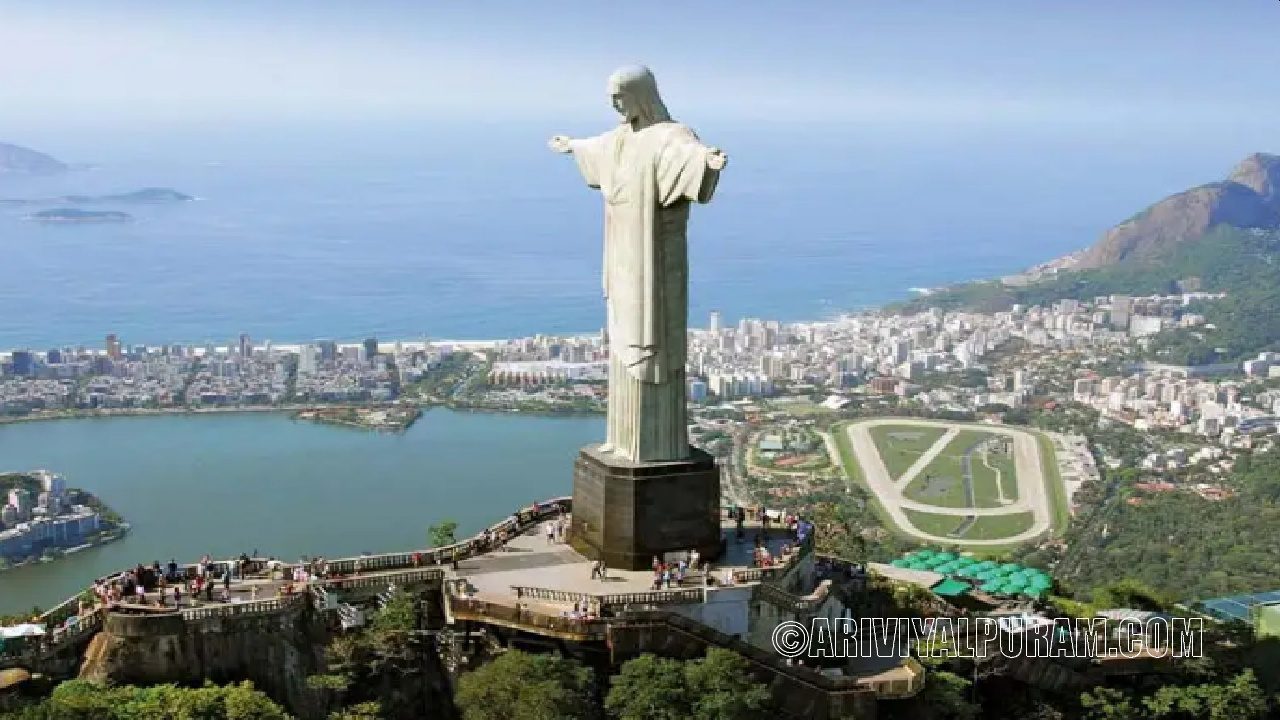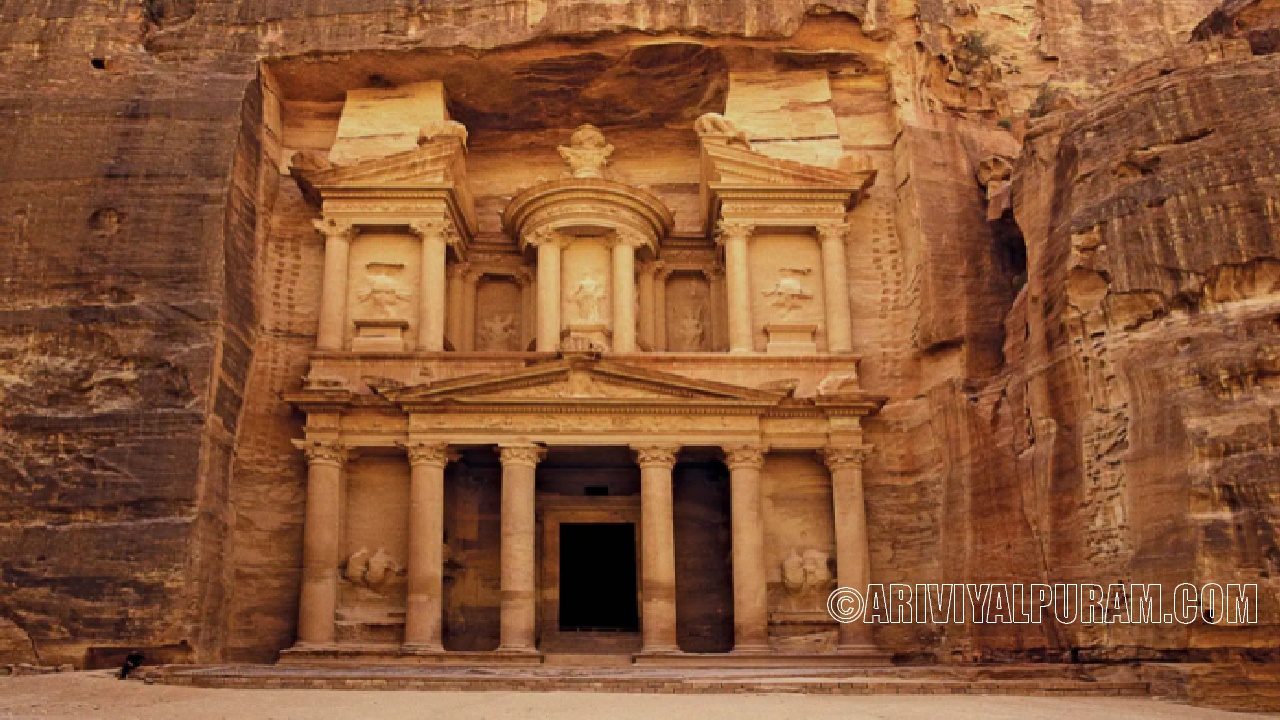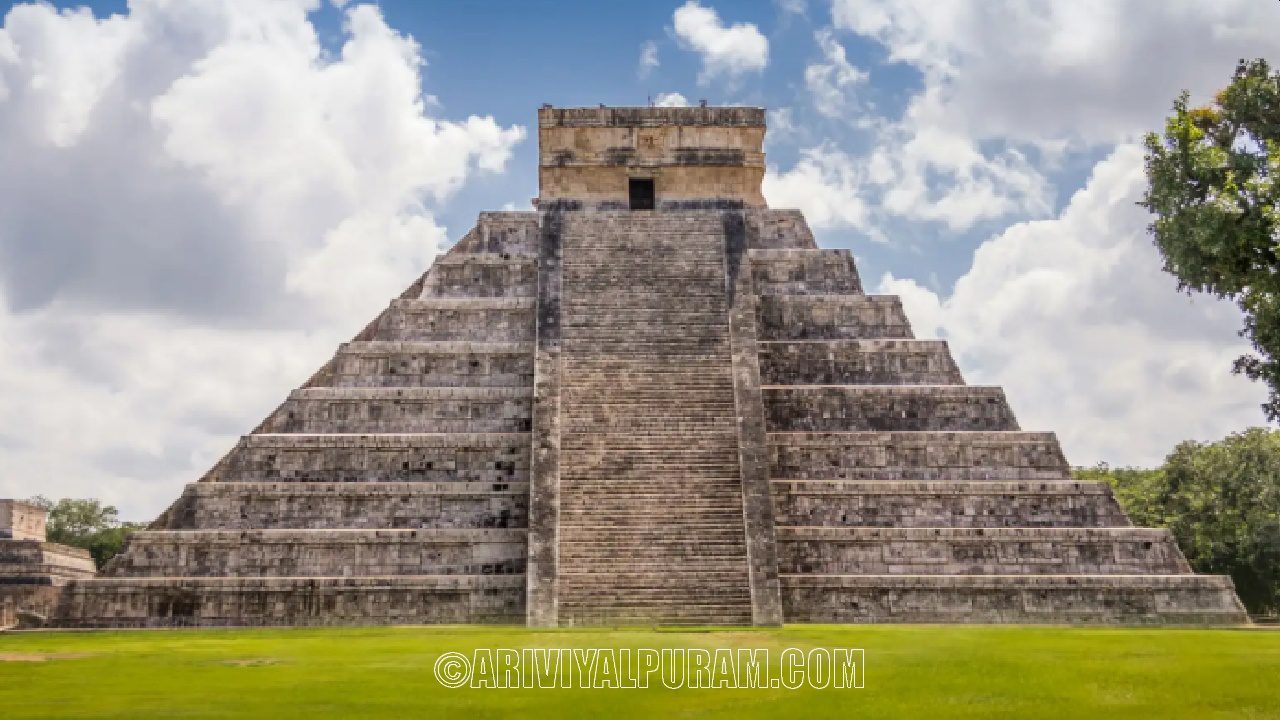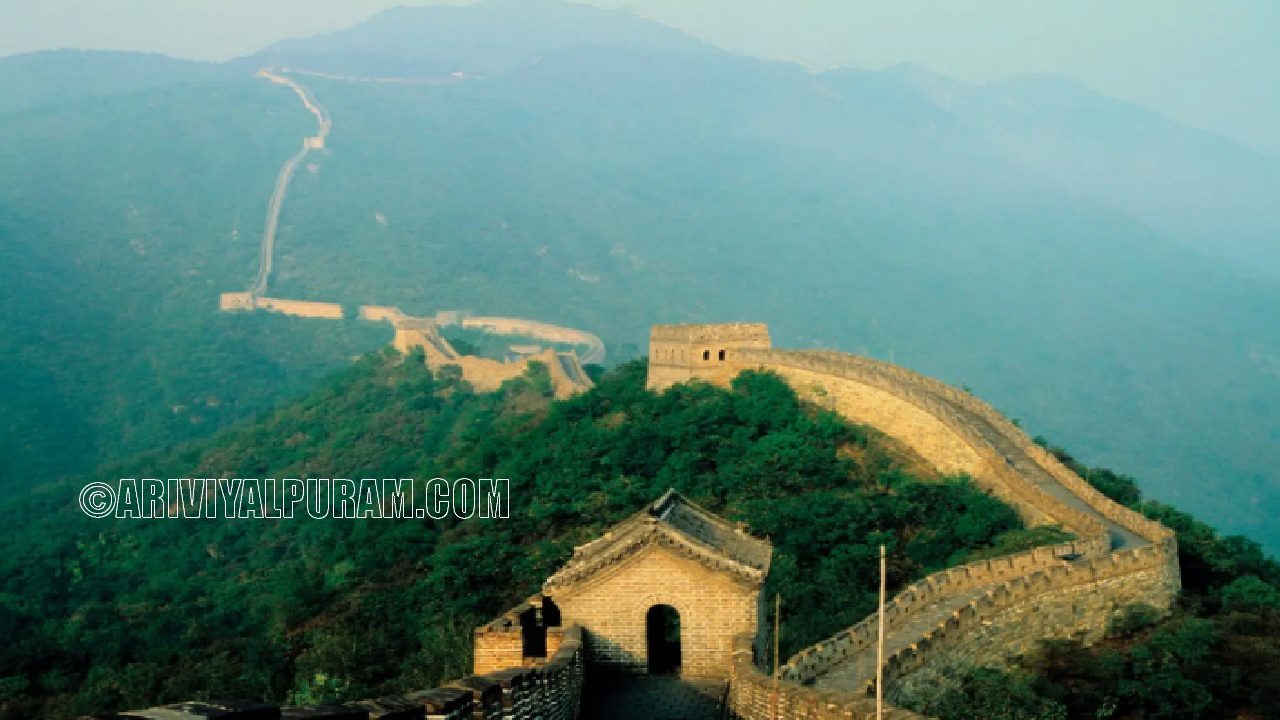2000 ஆம் ஆண்டில், ஒரு சுவிஸ் அறக்கட்டளை உலகின் புதிய (New Seven Wonders) ஏழு அதிசயங்களைத் தீர்மானிக்க ஒரு பிரச்சாரத்தைத் தொடங்கியது. அசல் ஏழு அதிசயங்களின் பட்டியல் கிமு 2 ஆம் நூற்றாண்டில் தொகுக்கப்பட்டது – மேலும் ஒரே ஒரு நுழைவு இன்னும் நிற்கிறது (கிசாவின் பிரமிடுகள்) – இது ஒரு புதுப்பித்தலுக்கான நேரம் என்று தோன்றியது.
100 மில்லியனுக்கும் அதிகமான வாக்குகள் இணையத்தில் அல்லது குறுஞ்செய்தி மூலம் அளிக்கப்பட்டதால், உலகம் முழுவதும் உள்ள மக்கள் வெளிப்படையாக ஒப்புக்கொண்டனர். 2007 இல் அறிவிக்கப்பட்ட இறுதி முடிவுகள், ஆரவாரத்தோடும் சில கேலிக்கூத்துகளோடும் சந்தித்தன – ஏதென்ஸின் அக்ரோபோலிஸ் போன்ற பல முக்கிய போட்டியாளர்கள், வெட்டுக்களைச் செய்யத் தவறிவிட்டனர். புதிய பட்டியலை ஏற்கிறீர்களா?
தாஜ் மஹால்

இந்தியாவின் ஆக்ராவில் உள்ள இந்த கல்லறை வளாகம், உலகின் மிகச் சிறந்த நினைவுச்சின்னங்களில் ஒன்றாக கருதப்படுகிறது மற்றும் முகலாய கட்டிடக்கலைக்கு சிறந்த எடுத்துக்காட்டு. 1631 ஆம் ஆண்டு 14 வது குழந்தையைப் பெற்றெடுத்து இறந்த தனது மனைவி மும்தாஸ் மஹால் (“அரண்மனையில் தேர்ந்தெடுக்கப்பட்டவர்”) கௌரவிக்க பேரரசர் ஷாஜஹான் (1628-58 ஆட்சி) கட்டினார்.
இந்த வளாகத்தை உருவாக்க சுமார் 22 ஆண்டுகள் மற்றும் 20,000 தொழிலாளர்கள் தேவைப்பட்டனர், அதில் பிரதிபலிக்கும் குளம் கொண்ட ஒரு பெரிய தோட்டம் உள்ளது. இந்த கல்லறை வெள்ளை பளிங்கு கற்களால் ஆனது, இது வடிவியல் மற்றும் மலர் வடிவங்களில் அரை விலையுயர்ந்த கற்களைக் கொண்டுள்ளது. அதன் கம்பீரமான மையக் குவிமாடம் நான்கு சிறிய குவிமாடங்களால் சூழப்பட்டுள்ளது. சில தகவல்களின்படி, ஷாஜகான் தனது சொந்த கல்லறையை கருப்பு பளிங்குக் கல்லால் உருவாக்க விரும்பினார். இருப்பினும், எந்த வேலையும் தொடங்குவதற்கு முன்பே அவரது மகன்களில் ஒருவரால் அவர் பதவி நீக்கம் செய்யப்பட்டார்.
கொலோசியம்

ரோமில் உள்ள கொலோசியம் பேரரசர் வெஸ்பாசியன் உத்தரவின் பேரில் முதல் நூற்றாண்டில் கட்டப்பட்டது. பொறியியலின் ஒரு சாதனை, ஆம்பிதியேட்டர் 620 க்கு 513 அடி (189 x 156 மீட்டர்) மற்றும் சிக்கலான பெட்டக அமைப்பைக் கொண்டுள்ளது. இது 50,000 பார்வையாளர்களை வைத்திருக்கும் திறன் கொண்டது, அவர்கள் பல்வேறு நிகழ்வுகளைப் பார்த்தனர்.
கிளாடியேட்டர் சண்டைகள் மிகவும் குறிப்பிடத்தக்கவை, இருப்பினும் ஆண்கள் விலங்குகளுடன் சண்டையிடுவது பொதுவானது. கூடுதலாக, சில சமயங்களில் போலி கடற்படை ஈடுபாடுகளுக்காக கொலோசியத்தில் தண்ணீர் செலுத்தப்பட்டது. இருப்பினும், கிறிஸ்தவர்கள் அங்கு தியாகிகளாக – அதாவது, சிங்கங்களுக்கு எறியப்பட்டதன் மூலம் – என்ற நம்பிக்கை விவாதத்திற்குரியது. சில மதிப்பீடுகளின்படி, கொலோசியத்தில் சுமார் 500,000 பேர் இறந்தனர். கூடுதலாக, பல விலங்குகள் கைப்பற்றப்பட்டு பின்னர் கொல்லப்பட்டன, சில இனங்கள் அழிந்துவிட்டதாக கூறப்படுகிறது.
கிறிஸ்து மீட்பர்

ரியோ டி ஜெனிரோவில் உள்ள கோர்கோவாடோ மலையின் உச்சியில் கிறிஸ்ட் தி ரிடீமர், இயேசுவின் பிரம்மாண்டமான சிலை. அதன் தோற்றம் முதலாம் உலகப் போருக்குப் பிறகு, சில பிரேசிலியர்கள் “கடவுள் அற்ற அலைக்கு” அஞ்சினார்கள். அவர்கள் ஒரு சிலையை முன்மொழிந்தனர், இது இறுதியில் ஹெய்ட்டர் டா சில்வா கோஸ்டா, கார்லோஸ் ஓஸ்வால்ட் மற்றும் பால் லாண்டோவ்ஸ்கி ஆகியோரால் வடிவமைக்கப்பட்டது.
கட்டுமானம் 1926 இல் தொடங்கியது மற்றும் ஐந்து ஆண்டுகளுக்குப் பிறகு முடிக்கப்பட்டது. இதன் விளைவாக உருவான நினைவுச்சின்னம் 98 அடி (30 மீட்டர்) உயரமாக உள்ளது-அதன் அடித்தளம் உட்பட, இது சுமார் 26 அடி (8 மீட்டர்) உயரம் கொண்டது-மற்றும் அதன் நீட்டப்பட்ட கைகள் 92 அடி (28 மீட்டர்) வரை இருக்கும். இது உலகின் மிகப்பெரிய ஆர்ட் டெகோ சிற்பம் ஆகும். கிறிஸ்ட் தி ரிடீமர் வலுவூட்டப்பட்ட கான்கிரீட்டால் ஆனது மற்றும் சுமார் ஆறு மில்லியன் ஓடுகளால் மூடப்பட்டிருக்கும். சற்றே குழப்பமாக, சிலை அடிக்கடி மின்னலால் தாக்கப்பட்டது, மேலும் 2014 இல் புயலின் போது இயேசுவின் வலது கட்டைவிரலின் நுனி சேதமடைந்தது.
மச்சு பிச்சு

பெரு, குஸ்கோவிற்கு அருகிலுள்ள இந்த இன்கான் தளம் 1911 ஆம் ஆண்டில் ஹிராம் பிங்காம் என்பவரால் “கண்டுபிடிக்கப்பட்டது”, இது 16 ஆம் நூற்றாண்டின் ஸ்பானிஷ் ஆட்சிக்கு எதிரான கிளர்ச்சியின் போது பயன்படுத்தப்பட்ட இரகசிய இன்கா கோட்டையான வில்கபாம்பா என்று நம்பினார். அந்தக் கூற்று பின்னர் நிராகரிக்கப்பட்டது என்றாலும், மச்சு பிச்சுவின் நோக்கம் அறிஞர்களை குழப்பியது. கற்பு சபதத்தின் கீழ் கான்வென்ட்களில் வாழ்ந்த பெண்கள் “சூரியனின் கன்னிகள்” வசிக்கும் வீடு என்று பிங்காம் நம்பினார்.
மற்றவர்கள் இது ஒரு புனித யாத்திரையாக இருக்கலாம் என்று நினைக்கிறார்கள், சிலர் இது ஒரு அரச பின்வாங்கல் என்று நம்புகிறார்கள். (இது வெளிப்படையாக இருக்கக் கூடாத ஒன்று, ஒரு பீர் வணிகத்தின் தளம். 2000 ஆம் ஆண்டில், அத்தகைய விளம்பரத்திற்காக பயன்படுத்தப்பட்ட ஒரு கிரேன் ஒரு நினைவுச்சின்னத்தில் விழுந்து, ஒரு நினைவுச்சின்னத்தில் விரிசல் ஏற்பட்டது.) அறியப்பட்ட விஷயம் என்னவென்றால், கொலம்பியனுக்கு முந்தைய சில முக்கிய இடிபாடுகளில் மச்சு பிச்சுவும் ஒன்றாகும். கிட்டத்தட்ட அப்படியே காணப்பட்டது. ஆண்டிஸ் மலைகளில் அதன் ஒப்பீட்டளவில் தனிமைப்படுத்தப்பட்ட போதிலும், இது விவசாய மொட்டை மாடிகள், பிளாசாக்கள், குடியிருப்பு பகுதிகள் மற்றும் கோயில்களைக் கொண்டுள்ளது.
பெட்ரா

ஜோர்டானின் பண்டைய நகரமான பெட்ரா, மணற்கல் மலைகள் மற்றும் பாறைகளுக்கு மத்தியில் அமைந்துள்ள தொலைதூர பள்ளத்தாக்கில் அமைந்துள்ளது. மோசஸ் ஒரு பாறையை அடித்த மற்றும் தண்ணீர் வெளியேறிய இடங்களில் ஒன்றாக இது கருதப்படுகிறது. பின்னர் அரபு பழங்குடியினரான Nabataeans, அதை தங்கள் தலைநகராக மாற்றியது, இந்த நேரத்தில் அது செழித்து, ஒரு முக்கியமான வர்த்தக மையமாக மாறியது, குறிப்பாக மசாலாப் பொருட்களுக்கான. பிரபலமான செதுக்குபவர்கள், நபாட்டியன்கள் குடியிருப்புகள், கோவில்கள் மற்றும் கல்லறைகளை மணற்கல்களாக வெட்டினர், இது சூரியன் மாறும் போது நிறத்தை மாற்றியது. கூடுதலாக, அவர்கள் பசுமையான தோட்டங்கள் மற்றும் விவசாயத்திற்கு அனுமதிக்கும் நீர் அமைப்பை உருவாக்கினர். அதன் உயரத்தில், பெட்ரா 30,000 மக்கள்தொகையைக் கொண்டிருந்ததாகக் கூறப்படுகிறது.
இருப்பினும், வணிக வழிகள் மாறியதால் நகரம் வீழ்ச்சியடையத் தொடங்கியது. 363 CE இல் ஒரு பெரிய பூகம்பம் அதிக சிரமத்தை ஏற்படுத்தியது, மேலும் 551 இல் ஏற்பட்ட மற்றொரு நடுக்கத்திற்குப் பிறகு, பெட்ரா படிப்படியாக கைவிடப்பட்டது. 1912 இல் மீண்டும் கண்டுபிடிக்கப்பட்டாலும், 20 ஆம் நூற்றாண்டின் பிற்பகுதி வரை தொல்பொருள் ஆராய்ச்சியாளர்களால் இது பெரும்பாலும் புறக்கணிக்கப்பட்டது, மேலும் நகரத்தைப் பற்றி பல கேள்விகள் உள்ளன.
சிச்சென் இட்சா

சிச்சென் இட்சா என்பது மெக்ஸிகோவில் உள்ள யுகடன் தீபகற்பத்தில் உள்ள ஒரு மாயன் நகரமாகும், இது கிபி 9 மற்றும் 10 ஆம் நூற்றாண்டுகளில் செழித்து வளர்ந்தது. மாயன் பழங்குடியினரான இட்சாவின் கீழ் – அவர் டோல்டெக்குகளால் கடுமையாக தாக்கப்பட்டார் – பல முக்கியமான நினைவுச்சின்னங்கள் மற்றும் கோவில்கள் கட்டப்பட்டன. மெயின் பிளாசாவில் இருந்து 79 அடி (24 மீட்டர்) உயரத்தில் உள்ள எல் காஸ்டிலோ (“தி கேஸில்”) என்ற படிநிலை பிரமிடு மிகவும் குறிப்பிடத்தக்கது.
மாயன்களின் வானியல் திறன்களுக்கு ஒரு சான்று, இந்த அமைப்பு மொத்தம் 365 படிகளைக் கொண்டுள்ளது, சூரிய வருடத்தின் நாட்களின் எண்ணிக்கை. வசந்த கால மற்றும் இலையுதிர்கால உத்தராயணத்தின் போது, சூரிய அஸ்தமனம் பிரமிட்டின் மீது நிழல்களை ஏற்படுத்துகிறது, இது வடக்கு படிக்கட்டில் ஒரு பாம்பு சறுக்குவது போன்ற தோற்றத்தை அளிக்கிறது; அடிவாரத்தில் ஒரு கல் பாம்பு முனை உள்ளது. இருப்பினும், அங்குள்ள வாழ்க்கை அனைத்தும் வேலை மற்றும் அறிவியல் அல்ல. சிச்சென் இட்சா அமெரிக்காவின் மிகப்பெரிய ட்லாச்ட்லி (ஒரு வகை விளையாட்டு மைதானம்) உள்ளது. அந்த மைதானத்தில், குடியிருப்பாளர்கள் கொலம்பியனுக்கு முந்தைய மெசோஅமெரிக்கா முழுவதும் பிரபலமான ஒரு சடங்கு பந்து விளையாட்டை விளையாடினர்.
சீனப் பெருஞ்சுவர்

பெரிய ஒரு குறையாக இருக்கலாம். உலகின் மிகப்பெரிய கட்டிட-கட்டுமான திட்டங்களில் ஒன்றான, சீனப் பெருஞ்சுவர் சுமார் 5,500 மைல்கள் (8,850 கிமீ) நீளமாக இருப்பதாக பரவலாகக் கருதப்படுகிறது; இருப்பினும், ஒரு சர்ச்சைக்குரிய சீன ஆய்வு, நீளம் 13,170 மைல்கள் (21,200 கிமீ) எனக் கூறுகிறது. கிமு 7 ஆம் நூற்றாண்டில் வேலை தொடங்கியது மற்றும் இரண்டு ஆயிரம் ஆண்டுகளாக தொடர்ந்தது.
“சுவர்” என்று அழைக்கப்பட்டாலும், இந்த அமைப்பு உண்மையில் நீண்ட நீளத்திற்கு இரண்டு இணையான சுவர்களைக் கொண்டுள்ளது. கூடுதலாக, காவற்கோபுரங்கள் மற்றும் படைமுகாம்கள் அரணாக உள்ளன. இருப்பினும், சுவரைப் பற்றிய ஒரு பெரிய விஷயம் இல்லை, அதன் செயல்திறன். படையெடுப்புகள் மற்றும் தாக்குதல்களைத் தடுக்க இது கட்டப்பட்டாலும், உண்மையான பாதுகாப்பை வழங்குவதில் சுவர் பெரும்பாலும் தோல்வியடைந்தது. மாறாக, அது “அரசியல் பிரச்சாரமாக” அதிகம் செயல்பட்டதாக அறிஞர்கள் குறிப்பிட்டுள்ளனர்.
New Seven Wonders
In 2000 a Swiss foundation launched a campaign to determine the New Seven Wonders of the World. Given that the original Seven Wonders list was compiled in the 2nd century BCE — and that only one entrant is still standing (the Pyramids of Giza) — it seemed time for an update.
And people around the world apparently agreed, as more than 100 million votes were cast on the Internet or by text messaging. The final results, which were announced in 2007, were met with cheers as well as some jeers—a number of prominent contenders, such as Athens’s Acropolis, failed to make the cut. Do you agree with the new list?
Taj Mahal

Located in Agra, India, this mausoleum is considered one of the finest monuments in the world and is a fine example of Mughal architecture. It was built by Emperor Shah Jahan (reigned 1628-58) in 1631 to honor his wife Mumtaz Mahal (“the chosen one in the palace”) who gave birth to her 14th child and died.
It took about 22 years and 20,000 workers to build the campus, which has a large garden with a reflective pond. The tomb is made of white marble and contains semi-precious stones in geometric and floral patterns. Its majestic central dome is surrounded by four smaller domes. According to some sources, Shah Jahan wanted to build his own tomb in black marble. However, he was fired by one of his sons before any work could begin.
Colosseum

The Colosseum in Rome was built in the first century by order of Emperor Vespasian. An engineering record, the Amphitheater 620 measures 513 feet (189 x 156 meters) and has a sophisticated locker system. It has the capacity to hold 50,000 spectators and they watched various events.
Gladiator fights are notable, although it is common for men to fight with animals. In addition, water was sometimes pumped into the Colosseum for pseudo-naval involvement. However, the belief that Christians were martyred there – that is, by being thrown to the lions – is debatable. According to some estimates, about 500,000 people died in the Colosseum. In addition, many animals were captured and later killed, and some species are said to be extinct.
Christ the Redeemer

Christ the Redeemer, the colossal statue of Jesus, on top of Mount Corcovado in Rio de Janeiro. Its Origin After World War I, some Brazilians feared a “godless wave”. They proposed a statue, which was eventually designed by Heather da Silva Costa, Carlos Oswald and Paul Landowski.
Construction began in 1926 and was completed five years later. The resulting monument is 98 feet (30 m) high — including its base — about 26 feet (8 m) high, and its outstretched arms stand up to 92 feet (28 m). It is the largest Art Deco sculpture in the world. Christ the Redeemer is made of reinforced concrete and covered with about six million tiles. Slightly confused, the statue was frequently struck by lightning, and the tip of Jesus’ right thumb was damaged during a storm in 2014.
Machu Picchu

This Incan site near Cusco, Peru, was “discovered” by Hiram Bingham in 1911, believed to be Wilkabamba, a secret Inca fortress used during the uprising against 16th-century Spanish rule. Although the claim was later refuted, Machu Picchu’s intentions confused scholars. Bingham believed that women who lived in convents under the vow of chastity lived in the “virgins of the sun”.
Others think it may be a pilgrimage, while others believe it is a royal retreat. (This should not be overstated, as it is the site of a beer business. In 2000, a crane used for such advertising fell on a monument and cracked.) What is known is that Machu Picchu was one of the few major pre-Columbian ruins. It looked almost like that. Despite its relative isolation in the Andes Mountains, it has agricultural terraces, plazas, residential areas and temples.
Petra

Petra, the ancient city of Jordan, is located in a remote valley between sandstone hills and cliffs. It is considered one of the places where Moses hit a rock and the water came out. Later the Nabataeans, the Arab tribes, made it their capital, during which time it prospered and became an important trading center, especially for spices. Famous carvers, Nabataeans carved apartments, temples and tombs into sandstone, which changed color as the sun changed. In addition, they created lush gardens and a water system that allowed for farming. At its height, Petra is said to have had a population of 30,000.
However, the city began to decline as trade routes changed. A major earthquake in 363 CE caused great inconvenience, and after another earthquake in 551, Petra was gradually abandoned. Although rediscovered in 1912, it was largely ignored by archaeologists until the late 20th century, and there are still many questions about the city.
Chichen Itza

Chichen Itza is a Mayan city on the Yucatan Peninsula in Mexico that flourished in the 9th and 10th centuries AD. Many important monuments and temples were built under the Ita, a Mayan tribe – who was severely attacked by the Toltecs. The most notable is the hierarchical pyramid of El Castillo (“The Castle”), 79 feet (24 m) above Main Plaza.
A testament to the astronomical abilities of the Mayans, the system has a total of 365 steps, the number of days in a solar year. During the spring and autumn sunrises, the sunset casts shadows over the pyramid, giving it the appearance of a snake sliding down the northern staircase; At the base is a stone snake tip. However, life there is not all work and science. Chichen Itza is America’s largest dachshund. At the stadium, residents played a ceremonial ball game popular throughout pre-Columbian Mesoamerica.
The Great Wall of China

The big one may be a downside. One of the world’s largest building projects, the Great Wall of China is widely estimated to be about 5,500 miles (8,850 km) long; However, a controversial Chinese study states that the length is 13,170 miles (21,200 km). Work began in the 7th century BC and continued for two thousand years.
Although so-called “wall”, this structure actually has two parallel walls of long length. In addition, there are watchtowers and barracks. However, there is one big thing about the wall, and its performance. Although it was built to prevent invasions and attacks, the wall often failed to provide real protection. On the contrary, scholars have noted that it was more of a “political campaign.”



